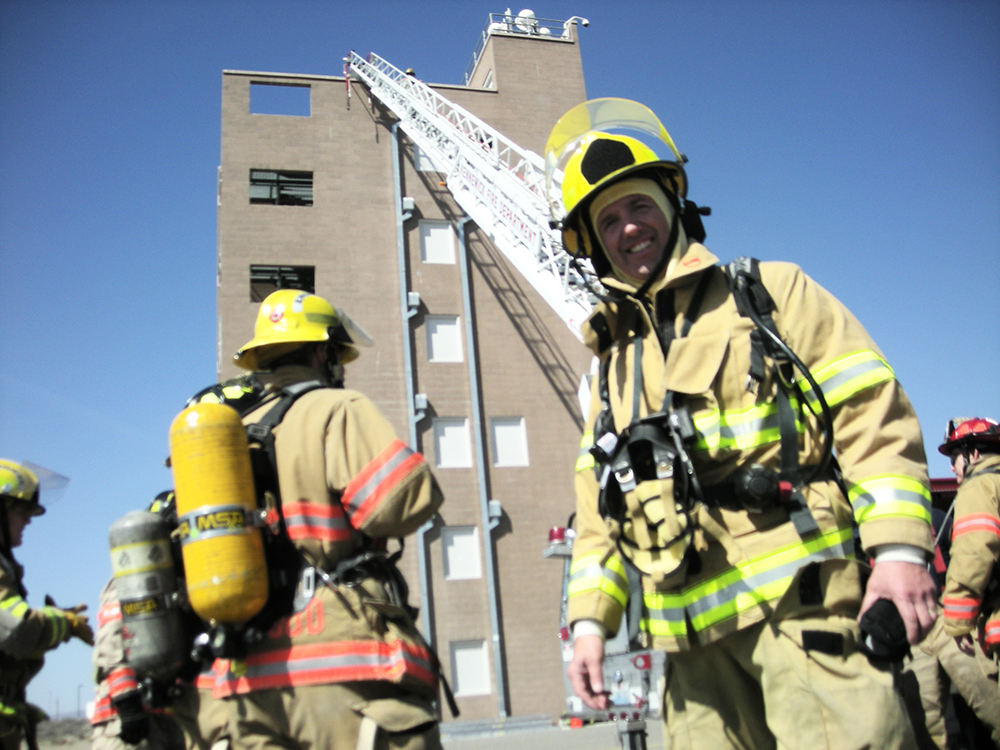Dave Fergus at the HAMMER Federal Training Center. Photo courtesy Rice Fergus Miller.
An Interview with Dave Fergus, of Rice Fergus Miller Architects
 How did RFM get started designing Fire Stations? What was the motivation?
How did RFM get started designing Fire Stations? What was the motivation?
 The first fire station we designed was in 1995 and was located a little over five miles from my home. Undertaking projects that served our community were, and have always been, central to our firm’s core values. That fire station project filled that passion, and then some. We found fire station projects, and the individuals associated with this particular industry, to be highly satisfying in terms of architecture and their support of the communities they served.
The first fire station we designed was in 1995 and was located a little over five miles from my home. Undertaking projects that served our community were, and have always been, central to our firm’s core values. That fire station project filled that passion, and then some. We found fire station projects, and the individuals associated with this particular industry, to be highly satisfying in terms of architecture and their support of the communities they served.
 How many fire stations has your firm designed?
How many fire stations has your firm designed?
 Over the past 19 years I’ve long lost track of how many fire stations I’ve walked through and advised how best to improve. From friendly advice for a fire chief wondering what to do to full-on construction projects, we’ve provided professional consulting services to more than 52 fire districts and departments throughout the State of Washington.
Over the past 19 years I’ve long lost track of how many fire stations I’ve walked through and advised how best to improve. From friendly advice for a fire chief wondering what to do to full-on construction projects, we’ve provided professional consulting services to more than 52 fire districts and departments throughout the State of Washington.
 How has your fire station design changed over the years?
How has your fire station design changed over the years?
 We’ve made a point to stay abreast of trends in fire station design, and helped to perpetuate a few trends of our own. The awareness of MRSA and other bad germs finding their way into firehouses has prompted less carpet and eliminated all fabric upholstery since this is where germs thrive. With the increasing number of women in the fire services, individual sleep rooms have replaced the traditional communal dorm room. Increases in presumptive cancers have challenged us to do better at getting diesel exhaust fumes out of the fire station entirely.
We’ve made a point to stay abreast of trends in fire station design, and helped to perpetuate a few trends of our own. The awareness of MRSA and other bad germs finding their way into firehouses has prompted less carpet and eliminated all fabric upholstery since this is where germs thrive. With the increasing number of women in the fire services, individual sleep rooms have replaced the traditional communal dorm room. Increases in presumptive cancers have challenged us to do better at getting diesel exhaust fumes out of the fire station entirely.
 What’s the most challenging part of designing fire stations?
What’s the most challenging part of designing fire stations?
 Fire stations are unique in that they operate under one set of criteria during the majority of the day, but under a different set of criteria when the tones go off. Direct and efficient circulation to the apparatus bay from wherever a firefighter is in the station reduces the amount of time it takes to get out the door. This improves services, and when the service is responding to emergencies, it can contribute to a more positive outcome for the individuals in need.
Fire stations are unique in that they operate under one set of criteria during the majority of the day, but under a different set of criteria when the tones go off. Direct and efficient circulation to the apparatus bay from wherever a firefighter is in the station reduces the amount of time it takes to get out the door. This improves services, and when the service is responding to emergencies, it can contribute to a more positive outcome for the individuals in need.
 In what ways is designing fire stations different than other structures your firm designs?
In what ways is designing fire stations different than other structures your firm designs?
 Fire stations are three projects all rolled up together. They’re a house – firefighters live there with accommodations for sleeping, cooking, and living. They’re a business, with offices, meeting rooms, and reception areas for serving the public. And, they’re a big commercial shop that houses 35-foot-long trucks, industrial compressors, and large equipment. Finding ways to integrate three very different functions under one roof provides great opportunities for creative and innovative solutions.
Fire stations are three projects all rolled up together. They’re a house – firefighters live there with accommodations for sleeping, cooking, and living. They’re a business, with offices, meeting rooms, and reception areas for serving the public. And, they’re a big commercial shop that houses 35-foot-long trucks, industrial compressors, and large equipment. Finding ways to integrate three very different functions under one roof provides great opportunities for creative and innovative solutions.
 What do you enjoy most about designing fire stations?
What do you enjoy most about designing fire stations?
 The people we work with and what they do every day.
The people we work with and what they do every day.
 Tell me a bit about a unique fire station that you worked on?
Tell me a bit about a unique fire station that you worked on?
 They are all unique so it’s difficult picking just one. Was it the big three-bay station we squeezed onto a tiny 100-foot-wide residential lot? Was it the station that served a town of just 500 people on the side of Mt. Rainier? Or, was it the overwater station on piers with its adjacent dock and ramp for a fireboat? Frankly, they’re all unique, which is why we find them to be such interesting and challenging projects.
They are all unique so it’s difficult picking just one. Was it the big three-bay station we squeezed onto a tiny 100-foot-wide residential lot? Was it the station that served a town of just 500 people on the side of Mt. Rainier? Or, was it the overwater station on piers with its adjacent dock and ramp for a fireboat? Frankly, they’re all unique, which is why we find them to be such interesting and challenging projects.
 To what extent are the actual fire fighters of the new facility included in the design process?
To what extent are the actual fire fighters of the new facility included in the design process?
 Anytime we can involve building users in the programming and planning process, the better the end results. These are the individuals who know firsthand the intricacies of their department’s culture and operational practices. They have insights into the little things – the things that bug them every day and the things they cherish. We’ve seen their input make the difference between a good project and a great one.
Anytime we can involve building users in the programming and planning process, the better the end results. These are the individuals who know firsthand the intricacies of their department’s culture and operational practices. They have insights into the little things – the things that bug them every day and the things they cherish. We’ve seen their input make the difference between a good project and a great one.
 Dave Fergus is a Senior Principal with the 40-person architecture firm Rice Fergus Miller in Bremerton, Washington. Dave is an expert at programming, planning, and designing public facilities. He has completed more than 200 civic projects over the last 20+ years including fire stations, schools, libraries, maintenance shops, and administrative headquarters. He regularly consults with public agencies on project feasibility, service locations, capital project funding, and other strategic issues.
Dave Fergus is a Senior Principal with the 40-person architecture firm Rice Fergus Miller in Bremerton, Washington. Dave is an expert at programming, planning, and designing public facilities. He has completed more than 200 civic projects over the last 20+ years including fire stations, schools, libraries, maintenance shops, and administrative headquarters. He regularly consults with public agencies on project feasibility, service locations, capital project funding, and other strategic issues.

